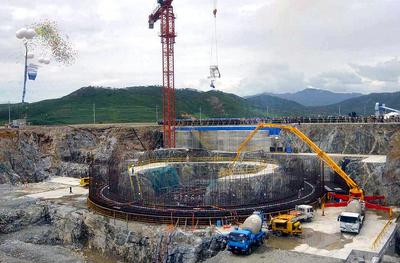In the post-Fukushima world, three new inexorable political pressures on nuclear decision makers have come to the fore.
The first is to accelerate direct disposal of nuclear waste while increasing underground interim spent fuel storage capacity — the latter necessary to ensure that aerial bombardment of a spent fuel pond does not result in a massive radiological release, rendering the surrounding land uninhabitable for thousands of years. The rapidly emerging deep borehole technology promises a realistic solution to this problem in the medium-term, but further investigation is needed. There appear to be suitable geological formations in both North and South Korea for placing high level nuclear wastes permanently into holes drilled three to five kilometres deep where the material will remain securely sequestered for millions of years. But to properly exploit this option North Korea cannot remain forever an enemy of the South.
The second trend is to look for new places to site reactors. The natural solution is to site them in North Korea and build a truly integrated, smart national grid that covers the whole of the Peninsula (and ties to the Russian, Chinese, Mongolian and Japanese grids). Thus, if the South wants safe siting of nuclear power, it needs to hasten the rapprochement with North Korea.
The third trend is to rethink the strategy of increasing reliance on nuclear power, which reduces technological diversity in the power sector and makes it vulnerable to severe technological flaws that can shut down many reactors at the same time. The introduction of a smart grid in South Korea, with a much stronger emphasis on renewable energy and efficiency, combined with decreasing reliance on nuclear power as a fraction of electricity supply, appears to be a sensible strategy. Such a strategy would reduce the risk of radiological hazard arising from state and non-state actor attacks on fuel cycle facilities in the South — a real hazard due to the continuing risk of war in the Peninsula.
The only places to find new sites for reactors are in the North or underground in the South. But it is hard to imagine Seoul engaging Pyongyang on cooperative approaches to power grids and reactors while conservatives rule in government. But given the threat of a nuclear accident in North Korea at the small light water reactor project, unveiled in November 2010 and under construction at Yongbyon, this is a risky situation.
After Fukushima, Seoul must make a choice.
It could engage the North to ensure that the small light water reactor project becomes an inter-Korean project, and is implemented adhering international safety standards. There is possibility that, like the KEDO project, the North’s Yongbyon project is driven by political imperatives to look strong at home, while offering an opportunity to the US and other parties, including South Korea, to engage the North — and assist its enrichment program. Obviously, this could not be done in isolation from resolution of the nuclear weapons issue and a radical shift in both South Korean and American policy towards the North.
Alternatively, Seoul could treat the North’s reactor as an emerging environmental security threat to South Korea’s population and land, raising the possibility of acting militarily to halt the reactor’s operation. (This could be as simple as cutting the power lines so that it has nowhere to transmit to, provided this is done early enough to ensure there is almost no radioactive waste fission products in the reactor core built up and able to vent to the atmosphere in case of a catastrophic cooling failure and meltdown). However, such a military intervention runs the risk of war.
A third path, between these two very difficult choices, is doing nothing: a faith-based strategy that risks a meltdown of the DPRK’s reactor with a massive radiation release over the South. A reactor accident in the North would almost certainly exceed the North’s capacity to respond to the physical and logistical demands of dealing with the site stabilisation and recovery operation, let alone evacuating large populations from downwind. Such an accident might lead to a humanitarian operation involving external forces, possibly orchestrated by China or Russia, and even involving South Korean experts, equipment and material.
Given these choices, it is clear the post-Fukushima landscape is one of opportunity and peril in the nuclear world. Seoul’s North Korea policy must be recast with the lessons of Fukushima in mind to ease the difficulties, and overcome the security dilemmas, of pursuing nuclear power in a very small, crowded Peninsula.
Peter Hayes is Professor of International Relations at the Royal Melbourne Institute of Technology and Executive Director of the Nautilus Institute, San Francisco.
This is an adapted version of a longer article authored by Professor Hayes, published by the Nautilus Institute, which can be found here.


An interesting article.
However I’m not sure North Korea, as it would appear the experimental light water reactor is still being built, scheduled for completion 2012 (http://iis-db.stanford.edu/evnts/6424/Heckerpresentation1.pdf).